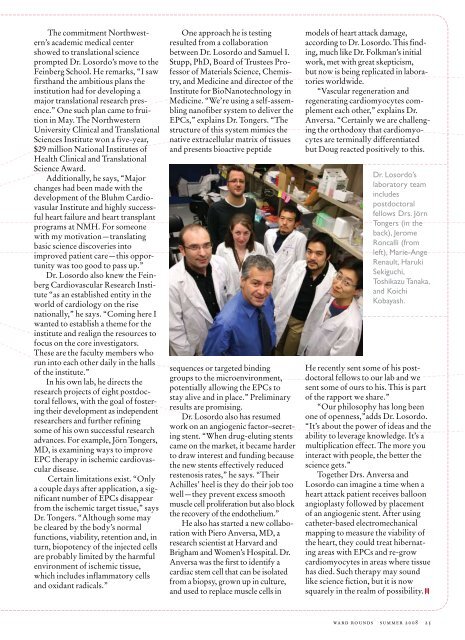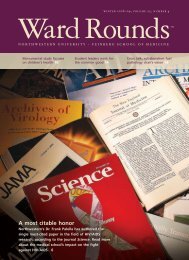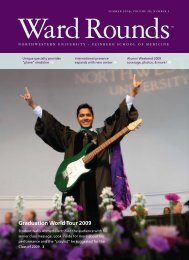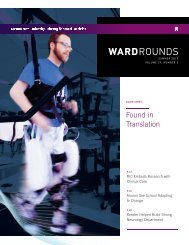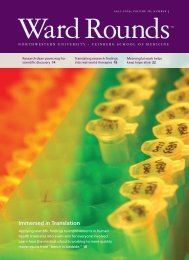Download PDF - Ward Rounds - Northwestern University
Download PDF - Ward Rounds - Northwestern University
Download PDF - Ward Rounds - Northwestern University
- No tags were found...
Create successful ePaper yourself
Turn your PDF publications into a flip-book with our unique Google optimized e-Paper software.
The commitment <strong>Northwestern</strong>’sacademic medical centershowed to translational scienceprompted Dr. Losordo’s move to theFeinberg School. He remarks, “I sawfirsthand the ambitious plans theinstitution had for developing amajor translational research presence.”One such plan came to fruitionin May. The <strong>Northwestern</strong><strong>University</strong> Clinical and TranslationalSciences Institute won a five-year,$29 million National Institutes ofHealth Clinical and TranslationalScience Award.Additionally, he says, “Majorchanges had been made with thedevelopment of the Bluhm CardiovasularInstitute and highly successfulheart failure and heart transplantprograms at NMH. For someonewith my motivation—translatingbasic science discoveries intoimproved patient care—this opportunitywas too good to pass up.”Dr. Losordo also knew the FeinbergCardiovascular Research Institute“as an established entity in theworld of cardiology on the risenationally,” he says. “Coming here Iwanted to establish a theme for theinstitute and realign the resources tofocus on the core investigators.These are the faculty members whorun into each other daily in the hallsof the institute.”In his own lab, he directs theresearch projects of eight postdoctoralfellows, with the goal of fosteringtheir development as independentresearchers and further refiningsome of his own successful researchadvances. For example, Jörn Tongers,MD, is examining ways to improveEPC therapy in ischemic cardiovasculardisease.Certain limitations exist. “Onlya couple days after application, a significantnumber of EPCs disappearfrom the ischemic target tissue,” saysDr. Tongers. “Although some maybe cleared by the body’s normalfunctions, viability, retention and, inturn, biopotency of the injected cellsare probably limited by the harmfulenvironment of ischemic tissue,which includes inflammatory cellsand oxidant radicals.”One approach he is testingresulted from a collaborationbetween Dr. Losordo and Samuel I.Stupp, PhD, Board of Trustees Professorof Materials Science, Chemistry,and Medicine and director of theInstitute for BioNanotechnology inMedicine. “We’re using a self-assemblingnanofiber system to deliver theEPCs,” explains Dr. Tongers. “Thestructure of this system mimics thenative extracellular matrix of tissuesand presents bioactive peptidesequences or targeted bindinggroups to the microenvironment,potentially allowing the EPCs tostay alive and in place.” Preliminaryresults are promising.Dr. Losordo also has resumedwork on an angiogenic factor–secretingstent. “When drug-eluting stentscame on the market, it became harderto draw interest and funding becausethe new stents effectively reducedrestenosis rates,” he says. “TheirAchilles’ heel is they do their job toowell—they prevent excess smoothmuscle cell proliferation but also blockthe recovery of the endothelium.”He also has started a new collaborationwith Piero Anversa, MD, aresearch scientist at Harvard andBrigham and Women’s Hospital. Dr.Anversa was the first to identify acardiac stem cell that can be isolatedfrom a biopsy, grown up in culture,and used to replace muscle cells inmodels of heart attack damage,according to Dr. Losordo. This finding,much like Dr. Folkman’s initialwork, met with great skepticism,but now is being replicated in laboratoriesworldwide.“Vascular regeneration andregenerating cardiomyocytes complementeach other,” explains Dr.Anversa. “Certainly we are challengingthe orthodoxy that cardiomyocytesare terminally differentiatedbut Doug reacted positively to this.Dr. Losordo’slaboratory teamincludespostdoctoralfellows Drs. JörnTongers (in theback), JeromeRoncalli (fromleft), Marie-AngeRenault, HarukiSekiguchi,Toshikazu Tanaka,and KoichiKobayash.He recently sent some of his postdoctoralfellows to our lab and wesent some of ours to his. This is partof the rapport we share.”“Our philosophy has long beenone of openness,”adds Dr. Losordo.“It’s about the power of ideas and theability to leverage knowledge. It’s amultiplication effect. The more youinteract with people, the better thescience gets.”Together Drs. Anversa andLosordo can imagine a time when aheart attack patient receives balloonangioplasty followed by placementof an angiogenic stent. After usingcatheter-based electromechanicalmapping to measure the viability ofthe heart, they could treat hibernatingareas with EPCs and re-growcardiomyocytes in areas where tissuehas died. Such therapy may soundlike science fiction, but it is nowsquarely in the realm of possibility.ward rounds summer 2008 25


